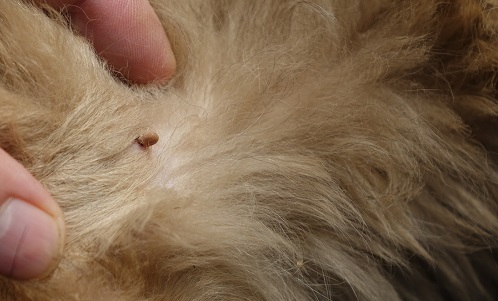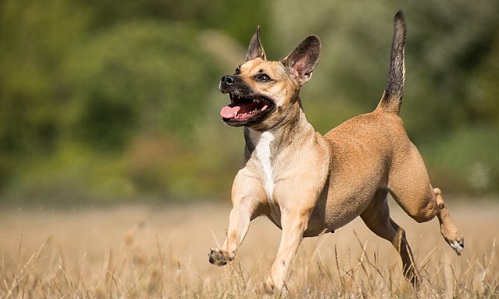Ticks are nasty little buggers that can plague your dog no matter how many safety measures you take to try to protect him. You can find ticks almost anywhere, but they seem more prevalent in wooded areas, especially during the warmer months of summer and spring, as well as the fall season.
They are less active during the winter months, but that doesn’t mean your dog can’t still pick up a little hitchhiker and bring it home when it’s cold out. The little bugs don’t fly, and they don’t jump, but they can fall on your dog from wherever they are roosting at the moment, and attach themselves for a ride, or climb on your dog when they brush up against an area, they are hanging out in. You should always be vigilant, especially if you live in areas that are especially inviting for ticks to congregate.
Also, keep in mind that where one tick is found, more may follow. If you find a tick on your dog or in your home, you should do a thorough check of both your house and your pet to make sure no other pests are present, waiting to cause mayhem. This post answers the question “what do tick bites on dogs look like?” and how they are removed. By the end of this article, you’ll know exactly what to do for tick bites on dogs.
What Are Ticks?
Ticks are parasites from the arachnid family, very similar to spiders or mites. Ticks love the woods, tall grasses, and lots of brush. If you live in areas like this, you probably have ticks nearby, waiting to attach themselves to their next host. Ticks are blood sucking parasites that can carry a whole host of diseases, although one of the most prevalent diseases ticks are known for carrying is canine Lyme disease. In addition to carrying tick-borne diseases, ticks can cause allergic reactions ranging from mild to severe and everything in between.
Dogs can even experience something called tick bite or Lyme disease paralysis, caused by a toxin certain female ticks carry that a dog is infected with when the tick bites the dog. You won’t usually see symptoms of this unless the dog is infested with several ticks, however, it’s not beyond the realms of possibility for one tick to cause all the damage, and it’s also entirely possible a dog will not experience tick paralysis at all, despite being a carrier of multiple ticks.
Dogs can also be infected with Lyme disease, anaplasmosis, ehrlichiosis, encephalitis, and Rocky Mountain spotted fever because of ticks, so they certainly aren’t something to shrug off and disregard. They are a parasite worth keeping an eye out for because of the many complications that can accompany their presence.
Symptoms of a Tick Bite or Infestation
Ticks can cause a whole host of different symptoms depending on how sensitive your dog is to their presence. Some dogs can experience inflammation and itching because of ticks. You may notice sores and scabbing in places where a tick has bitten them. Dogs may lick, scratch, or chew at the site of the bite and some dogs can develop other symptoms too, such as pain, canine lethargy, shivering, panting, canine appetite loss, fever, and even depression in dogs.
Another warning sign that your dog may have picked up a tick is excessive head shaking. Ticks can sometimes burrow into a dog’s ear canal and when they do, it will drive your dog bananas. They will shake their head and maybe even paw at their ears in an attempt to dislodge it.

Dogs can experience symptoms for a few hours, to days, to weeks. Dogs can also develop tick-borne diseases that can cause a whole host of their own sets of symptoms. tick paralysis, for instance, can cause a dog to appear lame or paralyzed, unable to move.
Some dogs experience symptoms that make them seem as though they are sleeping or in a coma. Other tick-borne diseases can cause inflammation throughout a dog’s body, gastro problems, immune function impairment, and even cause anemia that can become severe and potentially life-threatening.
What Do Ticks Look Like On Dogs & How Do You Find Them?
Start by running your hands through your dog’s fur to feel for any bumps. Ticks are small and can sometimes be difficult to spot, especially if your dog has thick hair. They love to hide out in warm, moist places and can normally be found around your dog’s ears, neck, head, or feet. However, ticks are equal opportunists and will more than happily attach themselves just about anywhere. You never know where one might turn up. Ticks can even be found in the groin area and around your dog’s bottom end. You’d be surprised at some of the many place’s ticks have been known to hide. Ticks can even attach themselves to a dog’s eyelid! They look a little bit like a tiny spider, with a little body shaped like an egg and eight legs to help them navigate to the best spot to settle in and feast.
If a tick has been attached for a while, they become much easier to find because their small bodies will swell up with all the blood they are ingesting, with some of them reaching the size of a small pea. They will also turn darker in color, which can cause them to blend into your dog’s fur. Use your fingers to carefully inspect your dog’s body from end to end because you can usually feel the presence of a tick, even if you can’t always see it.
Identifying Tick Bites
Unless the tick is still present, it’s going to be difficult to identify a tick bite. They are such small parasites that the bite is almost unnoticeable unless your dog has a reaction to it, or the tick is still there and feeding. If the tick is gone but the bite remains, your dog may experience some itchiness and redness around the bite site. However, if the tick is still there, you’ll be able to see it once you look closely enough. If it’s not fat enough to see the blood-filled sac yet, you should still be able to see its head and legs, where it has bitten and embedded itself into your dog’s skin.
Removing a Tick from Your Dog
It’s important if you find a tick to remove it right away. The longer it remains, the higher the chances of your dog contracting a tick-borne disease or experiencing other effects related to tick bites. However, ticks can be challenging to remove properly. If they are removed improperly your dog can still be at risk for disease, as well as develop a secondary skin infection, or suffer from inflammation and pain.
 To remove a tick properly, you should first clean the area with rubbing alcohol. Wear rubber gloves or use something to protect your hands so that you don’t accidentally expose yourself to potential disease, and extract the tick using a pair of tweezers. Using a hot match or something of that nature to remove the tick is an old wives’ tale and shouldn’t be done, you could accidentally cause the tick to burrow even deeper into your dog’s skin.
To remove a tick properly, you should first clean the area with rubbing alcohol. Wear rubber gloves or use something to protect your hands so that you don’t accidentally expose yourself to potential disease, and extract the tick using a pair of tweezers. Using a hot match or something of that nature to remove the tick is an old wives’ tale and shouldn’t be done, you could accidentally cause the tick to burrow even deeper into your dog’s skin.
Instead, grasp the tick firmly with the tweezers, angling them to grab the tick right at the base of the head. You’ll need to pull it out firmly and may feel a little bit of resistance at first as the tick attempts to cling to its food source. Keep pulling, gently but firmly, until the tick begins backing out on its own. Once the tick is removed, submerge it in alcohol to kill it completely. Once it’s dead, you can either keep the specimen to show your vet and possibly test it for disease, or you can flush it down the toilet and be done with it. The choice is yours, although preserving it so that your vet can test it for potential disease may be the wisest choice.
Sometimes the tick’s head will get stuck in your dog’s body, despite your best efforts. You can try removing it, but if you can’t get it, don’t stress too much. Your dog’s body will expel it eventually, though it’s much better to remove it completely.
You’ll want to check your dog thoroughly to make sure there are no other ticks present. If you’ve found one, it’s highly probable you may find another, so better to be safe than sorry. Once you’ve removed all the ticks from your dog’s body, you can bathe them and use warm, soapy water to clean the bite site. If your dog’s skin looks as though it may be infected, you can apply antibiotic ointment to treat it.
Preventing Ticks in Dogs
Though it’s impossible to completely eliminate the risk of ticks, you can take steps to prevent your dog from getting them. There are a variety of tick preventatives you can use on your dog, whether they are tablets, ointments, shampoos, sprays, or collars. Talk with your vet about the safest and most effective option for your dog and go from there. Some treatments may not be appropriate for younger dogs or could be toxic to small children, so it’s important to consider all of those things before deciding on a preventative measure. You can also ask your vet about certain vaccines that are available for preventing tick-borne diseases like Lyme disease.
You should always make it a habit to inspect your dog frequently, especially if you live in an area where ticks are prevalent. Make sure you check yourself as well because ticks don’t just hop on dogs. If your dog is vulnerable, so are you. Pay special attention to areas on your dog like their ears, inside and out, around the groin and anal area, around their eyes, in between their toes, and beneath their tail. Check their head and neck thoroughly, and feel around everywhere else, just to make sure you haven’t missed one. Check tender spots on your body too, especially in crevices and creases.
Make sure to keep your lawn mowed and treated for ticks, weeds pulled, and everything neatly groomed. Ticks love brush that is overgrown and areas that are thick with decaying leaves. They also love the fringes of your yard. Places where it is moist, warm, shady and dark. If you have a lot of potted plants and garden vegetation, you have the perfect environment for ticks to thrive. Keep those areas clean and well-groomed and keep your dog away from those areas as much as possible.
Another excellent preventative measure is avoiding taking your dog to locations where you know ticks are frequently found, such as hiking wooded trails. The less your dog is exposed to risk, the more that risk is reduced. Ticks like to do something called “questing” and they will wait for the perfect host to pass by their location. Avoid those locations, especially wooded areas, tall grasses, and thick brush, and you will avoid the ticks.
If you have more than one dog, you should always treat them all at the same time and inspect them all at the same time. If you check one dog but don’t check the other, you’re leaving both dogs vulnerable.
Ticks are nasty little parasites and they can carry with them all kinds of trouble for both you and your dog. Always do your best to prevent them and when that fails, treat the problem immediately, don’t wait. The longer you wait, the higher the risk of your dog developing additional health complications.
Sources:
Waggener, Natalie. “Signs to Look for If Your Dog Is Bitten by a Tick.” South Boston Animal Hospital, Accessed 4 Nov. 2018. www.southbostonanimalhospital.com/blog/signs-to-look-for-if-your-dog-is-bitten-by-a-tick.
“Tick Paralysis in Dogs.” PetMD, Accessed 4 Nov. 2018. www.petmd.com/dog/conditions/infectious-parasitic/c_dg_tick_paralysis.
“How to Spot, Remove and Prevent Ticks on Dogs.” Blue Cross, Accessed 4 Nov. 2018. www.bluecross.org.uk/pet-advice/dogs-and-ticks.
“How to Train Your Dog to Stop Chasing | Causes & Prevention.” Petwave, 30 Aug. 2016, Accessed 4 Nov. 2018. www.petwave.com/Dogs/Health/Ticks/Symptoms.aspx.
“Finding Ticks on Your Dog: 5 Places to Look.” PetMD, Accessed 4 Nov. 2018. www.petmd.com/dog/parasites/finding-ticks-your-dog-5-places-look.




